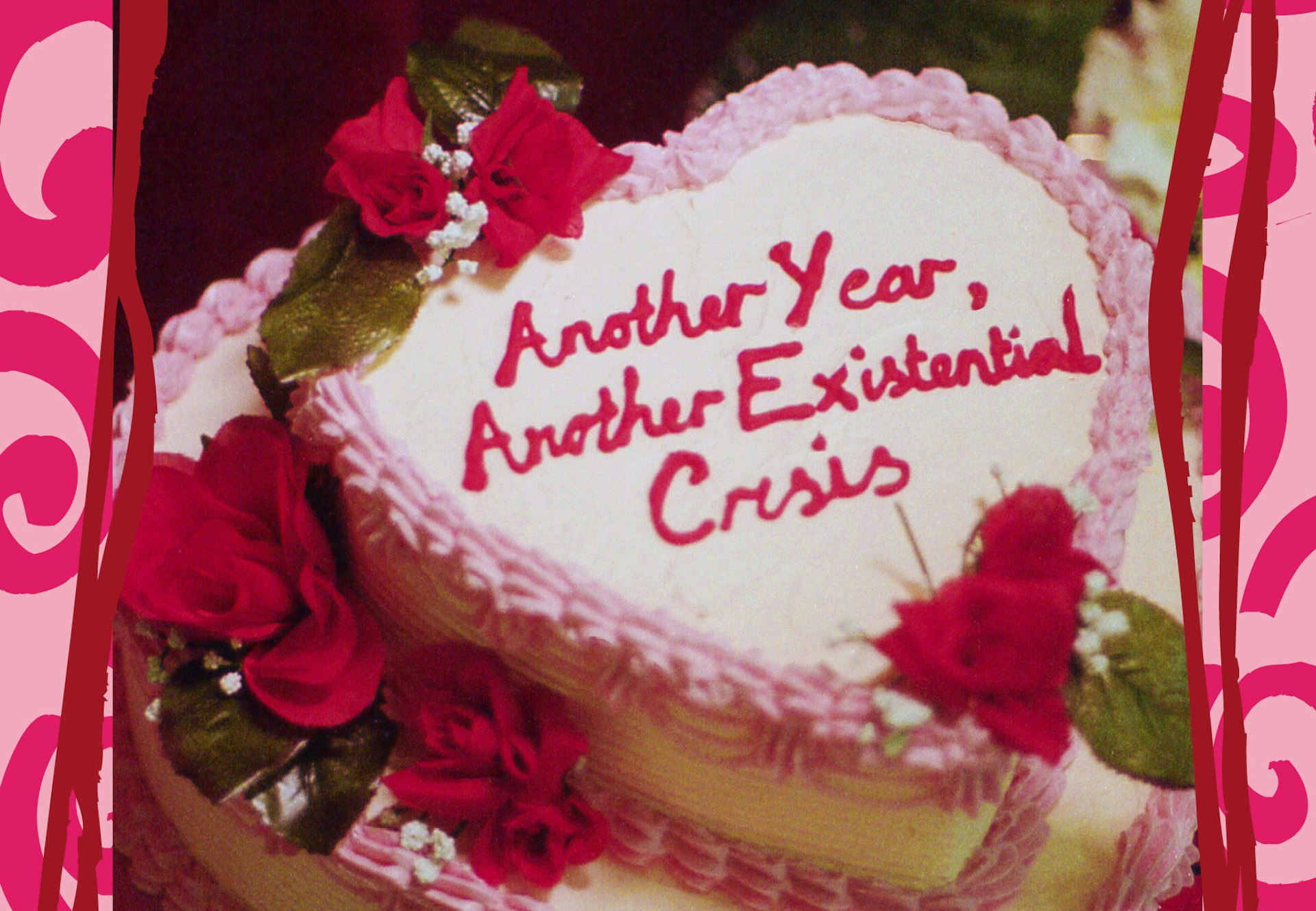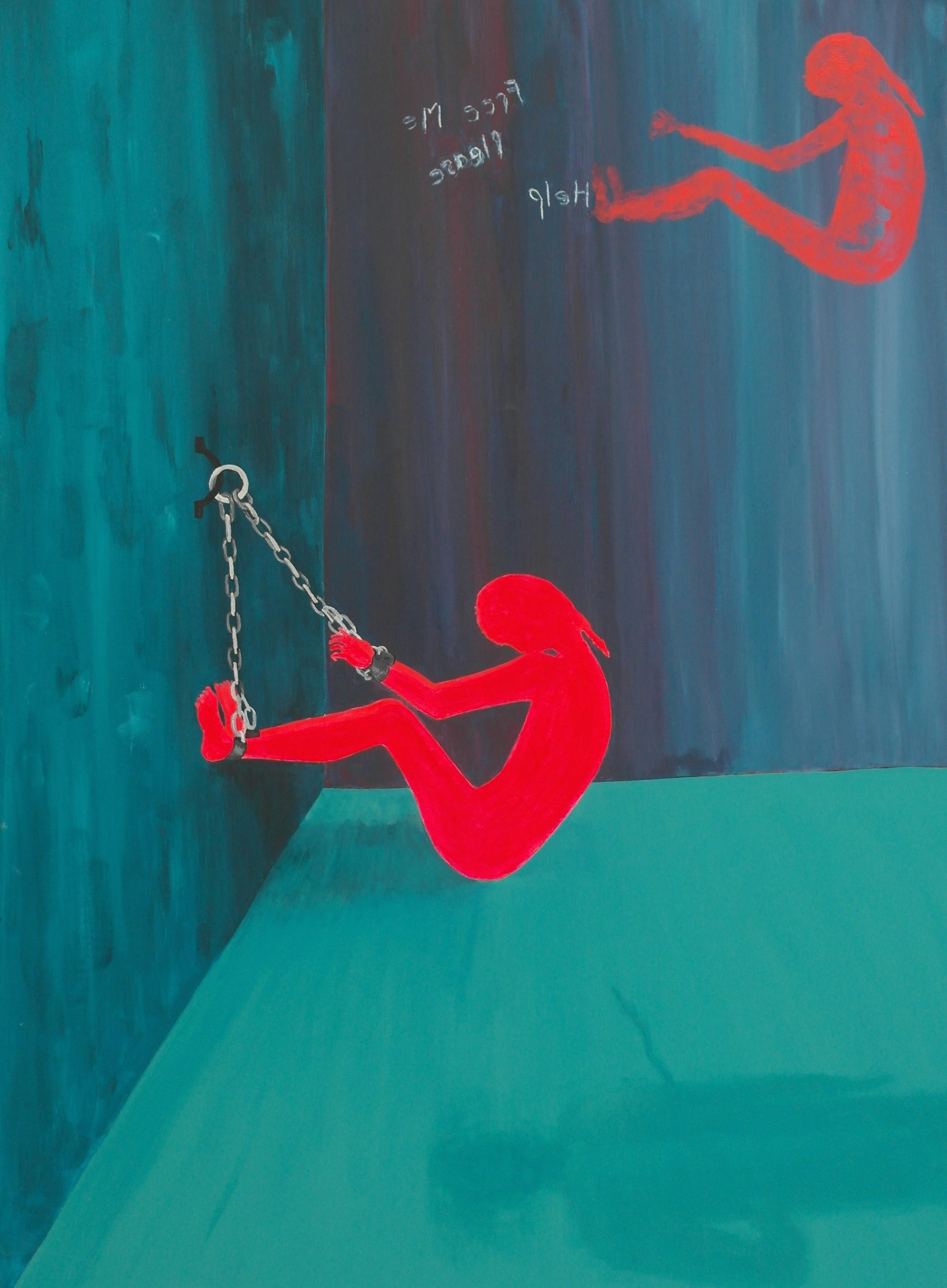
The woman who shares a body with 14 different artists
- Text by Alex Robert Ross
- Illustrations by Kim Noble
Patricia sits on a wooden chair in the sunlit ground-floor of the Zebra One gallery in Hampstead, London. Gucci spectacles are buried into her straw-red hair, which falls down as far as the shoulders of her powder blue coat. She points to a painting that’s standing on the floor. This one, she explains, is the work of Ria Pratt.
It’s one of the four paintings that Patricia brought in from her home in Croydon to show me. It’s a disquieting piece, brightly coloured, a fuscia figure on a turquoise background. It depicts a young woman with her hands and feet bound, chained to a wall, hunched.
In the top right of the canvas, there’s a faded recreation of the figure, like a stamped impression; to its left is an inscription scrawled backwards in white, as though it’s been cut into the paint: “FREE ME PLEASE HELP.”
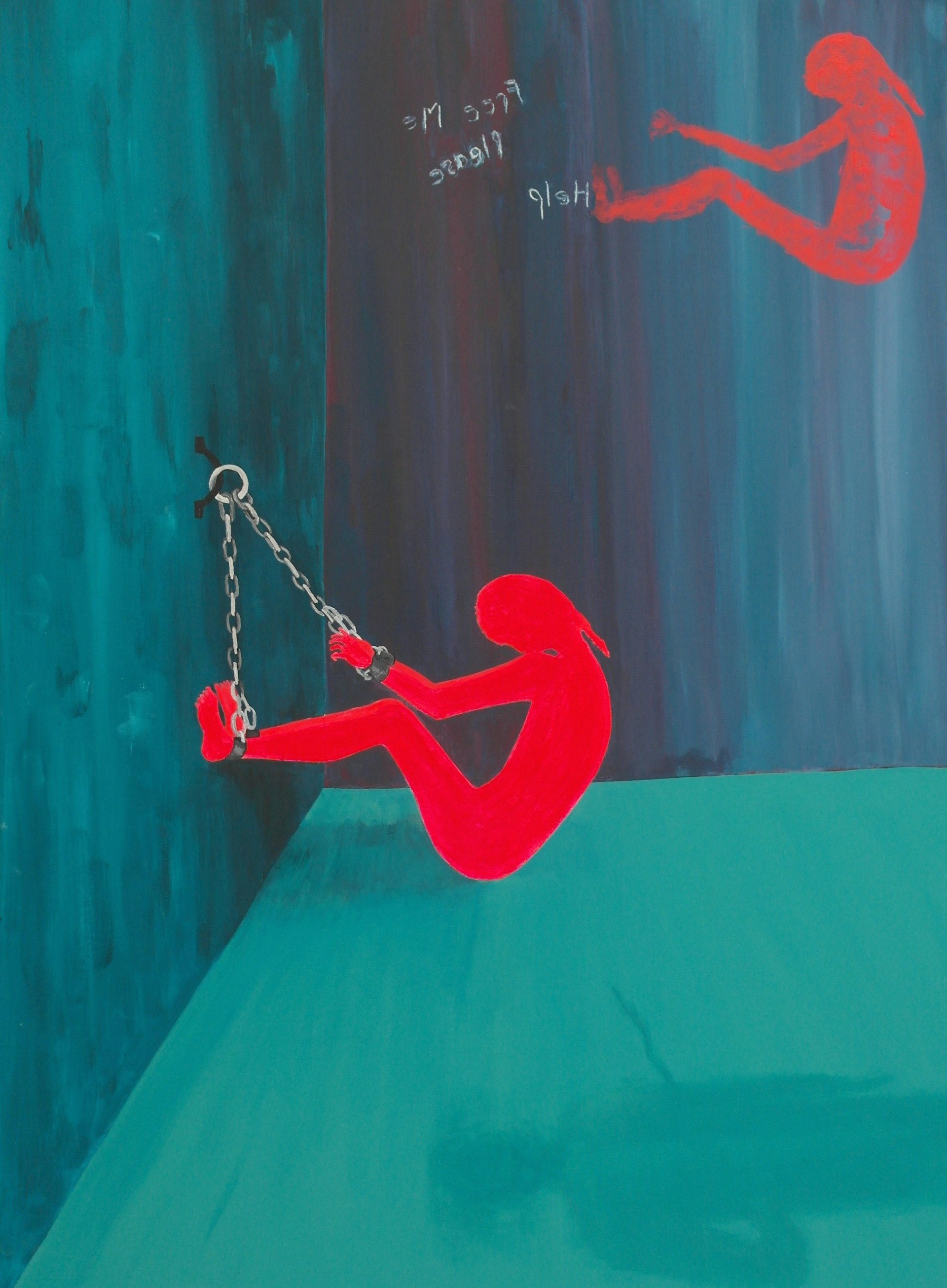
My Hands are Tied by Ria Pratt.
Ria Pratt, Patricia says, has spoken about her work before. “What she’s said is, especially with child abuse, people actually – especially years ago – turned a blind eye. It didn’t happen, you know. And I think by using the bright colours, you can’t miss it.”
Patricia thinks about this carefully, taking a moment to stare at the painting in silence before turning back towards me and saying in her throaty south London accent: “I think that is one of the reasons that she has been doing it.”
Though Patricia and Ria have never met, they both occupy the body of the 56-year-old artist Kim Noble, whose work will be exhibited alongside pieces by Salvador Dali, Charlie and Eddie Proudfoot, and Gerry Laffy as part of Zebra One’s forthcoming exhibition, With Art in Mind, opening in November.
Having been subjected to traumatic abuse as an infant, suicide attempts and hospital treatments in her teens, and confusing, dangerously destructive outbursts in her twenties, Noble was finally diagnosed with dissociative identity disorder (DID) in 1995.
It means that ‘Kim Noble’ exists on a birth certificate and now on the walls of galleries, but not as a unified individual. She is a set of ‘alters’ – distinct personalities that function independently of one another. The alters have no memory of one another’s activities and few, if any, share traits. Doctors have, perversely, described Noble as the “gold standard” for DID in the UK; experts know of nobody else whose alters are so many, so fully-formed, and so completely split from one another.

Kim Nobel / Mother & Babe by Anon.
Patricia, who sits across from me today, next to her 19-year-old daughter Aimee, is the dominant alter, the woman who is present most often. She is calm, funny, and self-effacing. There are 20 ‘main personalities’ within Kim Noble and dozens more fragments. 14 of those primary alters paint.
“I don’t mind being called Kim because I understand and know about the DID,” Patricia explains. “So realistically I understand that the body is Kim and I’m like more or less accepting that name now.”
But while Patricia understands DID, some of her other alters still haven’t grasped it. Some grow older with the passing of time, some remain rooted at a particular age, and many are simply unaware. “Some of the others, they don’t realise they’ve got DID, so they just still will go under their own name.”
The DID diagnosis was a watershed moment, but it wasn’t immediately simple. “It took me quite a while,” Patricia says. “I’d been told for quite a few years, ‘You’ve got DID’ and I didn’t accept it. But gradually, it did fall into place. Why was I forgetting things? Why were there all these paintings around that didn’t belong to me.”
In Kim Noble’s autobiography, All of Me, Patricia (who as the dominant alter wrote the book alongside ghostwriter Jeff Hudson), explains that the she’d been blaming her long blackouts and chaotic surroundings on alcohol until a doctor questioned just how much she’d actually been drinking. Not enough to account for the massive gaps in her short-term memory.
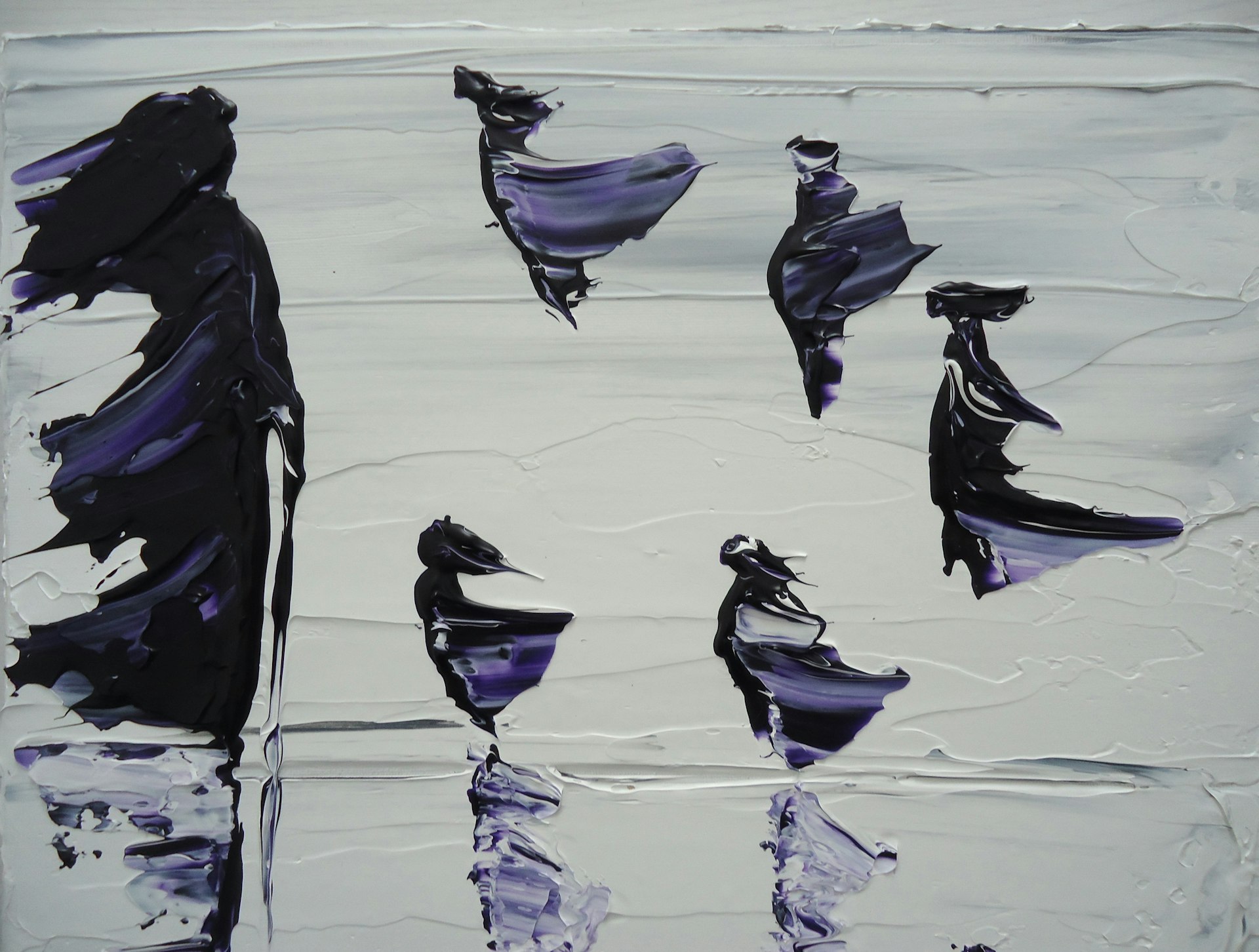
Training of the purple Spirit by Anon.
“Certain things were just adding up and clicking and coming together,” Patricia says. “It was a bit like denial, not trying to look.”
By chance, one of her support workers happened to be training as an art therapist, and she encouraged the many personalities of ‘Kim’ to paint. She started out using scraps of paper and borrowed paints from her then-infant daughter Aimee. Three months later, she went out, bought some supplies, and started in earnest.
“Really it was the best thing, knowing, because at least then you’ve got a bit more control of things. It’s not so out of control,” Patricia says. “Even though I’m not aware of the other personalities and I’ve got no control over them, since we’ve been painting, there’s a lot more calm. It’s not so chaotic.”
It is inherently very strange to interview a person with DID, mostly because you don’t know who to expect when you sit down. This is a particular challenge with Patricia precisely because she’s so easily charming. She is, she says, “generally quite a calm person,” something that’s reflected in her art, and this can put someone at ease extremely quickly.
And staring at the paintings now, each leaning on a different wall, it’s difficult to conceive of the fact that they all came from the same hand. To my left is a work by Judy, a temperamental but apparently outgoing teenager. It’s a small, busy portrait showing a young girl, eyes closed serenely, on a dried-blood-red background.
Opposite that is an imposing canvas by Anon, who only takes over at night, when nobody else is around, and hasn’t chosen to communicate a name by, say, signing a canvas. It’s a piece of abstract impressionism, lashings of thick black paint with sharp white interjections, like headlights at midnight. Then there’s a painting by Karen, a multicoloured constellation of splatters cutting through a creme background.
Patricia’s work is notable today by its absence. Until recently, she has almost exclusively painted gentle, modernist landscapes. And she isn’t particularly fond of them. “I find them very boring,” she says, smiling. “I feel that I haven’t really got very much to say about them. It’s really weird.”
She mentions one painting, a desert vista that fades upwards into rolling green hills. Somebody recently complimented her on that clash between the parched heat and lush grass. “I think that’s probably about the most interesting thing that’s been said about my paintings.”
So, to counteract this, she’s been taking cues from the mercurial Judy. Patricia likes Judy’s work, the “scratching and thick paint.” But when you share a body with an artist you admire, inspiration can be a tricky thing to navigate.
“It’s one thing being inspired by another artist,” Patricia says. “When it’s close to home, it feels a bit more like copying. So you can be inspired by an artist you don’t know, but once you know them, or know of them – as close as I am really to them – it feels [like] a bit of a copy.”
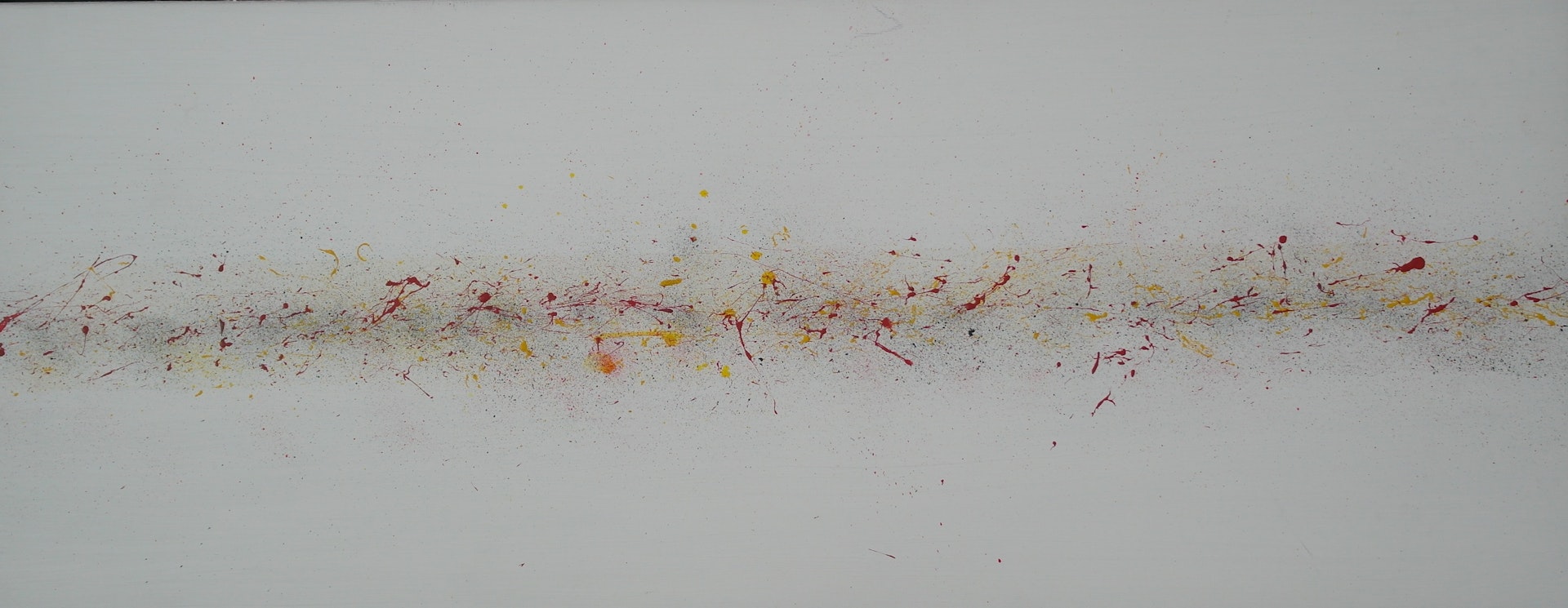
White Zen by Karen.
Dissociative identity disorder can be terrifying and destructive and there is nothing about the presence of multiple personalities that clears a path to artistry. It so happens that many of Kim’s alters have distinct talents and, over time, they have honed those gifts.
But DID is inescapably a creative response by the human brain. And Patricia, staring back at Judy’s troubled but peaceful portrait, sees that as something universal.
“I think it’s all artists, there’s something that they are trying to communicate, and I don’t think it’s always conscious,” she says. “I think it’s a way of communicating. Especially if you’re not able to verbalise how you’re feeling.”
Patricia realises that she’s in danger of speaking on behalf of her alters, so she doubles back. “I can’t always say too much about the paintings because it’s not me that’s painted it, so I can only look at it from anybody’s point of view, a third person looking at it.”
I ask Patricia if it feels strange to be exhibiting both her own work and the work of her alters, all under one name. And, typically, she finds a kernel of absurdity to the whole thing.
“No, I’d rather show their work than mine,” she says, stifling a laugh. “Because of my embarrassment. And also, if people don’t like any of theirs, I can say, ‘Well, it’s not mine! I didn’t do that one!’ You have confidence showing someone else’s work. If they like it you say, ‘That’s part of me that’s done that.’ If they don’t like it then, ‘Oh well.’”
With Art in Mind opens at Zebra One Gallery, London, 19 November.
Alex Robert Ross is a staff writer for Huck. You can follow him on Twitter.
Enjoyed this article? Like Huck on Facebook or follow us on Twitter.
